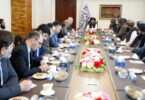Jiang Tianjiao
The head of U.S. Strategic Command (STRATCOM) Charles Richard recently warned that a nuclear war between the U.S. and China or Russia has become a “very real possibility.”
He wrote in the February issue of Proceedings, the U.S. Naval Institute’s monthly magazine, that, “There is a real possibility that a regional crisis with Russia or China could escalate quickly to a conflict involving nuclear weapons, if they perceived a conventional loss would threaten the regime or state.”
Consequently, the head of STRATCOM, which is responsible for the U.S. nuclear deterrent, incited the U.S. military to shift its principal assumption from “nuclear employment is not possible” to “nuclear employment is a very real possibility.”
Although hyping up the so-called “China threat” and “Russia threat” is just an all-too-common practice of the U.S. political and military circles, it’s still shocking to see a U.S. senior military official fabricating the groundless allegation.
As is known to all, ever since the first day of possessing nuclear weapons, China has declared the policy of no-first-use of nuclear weapons at any time and under any circumstances, and unconditionally commits itself not to use or threaten to use nuclear weapons against non-nuclear-weapon states or nuclear-weapon-free zones.
Therefore, as long as the U.S. does not launch a nuclear strike against China first, it does not need to worry that China will start a nuclear war.
However, the U.S. political and military circles often raise various questions. For example, if the U.S. destroys China’s nuclear missile bases with conventional weapons, will China use nuclear weapons to counterattack? Such a seemingly artful question actually reflects a kind of provocation and the offensive strategic thinking of America, which pursues pre-emptive attacks and wants to strangle its “rivals.”
Historically, China has been confronted with nuclear blackmail from the U.S. since the beginning of the Cold War. Even when the two countries agreed not to take each other as a target of strategic nuclear weapons after the Cold War, several U.S. administrations still put China on the list for nuclear strikes. It’s quite clear that the U.S. is more likely to start a nuclear war.
Knowing well enough about these facts, the STRATCOM commander still gave such a warning that startled the world for the following reasons.
He intends to keep Biden administration’s mouth shut. Many Americans see the new administration as an extension of a third Obama term as it is staffed with Obama veterans, particularly in the field of arms control.
They made great contributions to the signing of the New Strategic Arms Reduction Treaty (START) between the United States and Russia, and the signing of the Joint Comprehensive Plan of Action on Iran’s nuclear program. Some of them also praised highly Obama’s commitment to building a world without nuclear weapons.
A typical Democrat, Biden prefers to pursue arms control, and he participated in arms control negotiations between the U.S. and the former Soviet Union during the Cold War. Therefore, his administration desires to make new achievements in arms control. Following the extension of the New START treaty, the Biden administration may push for breakthroughs in a no-first-use policy when it comes to nuclear weapons.
To reduce the threat of a nuclear war, Obama tried to sign an executive order to adopt the no-first-use policy of nuclear weapons at the end of his term, which was strongly resisted by co-nservatives. Today, the Bi-den administration is likely to complete Obama’s unfinished work and reiterate no-first-use of nuclear weapons. Against such a background, Richard hyped up the hypothetical threat of a nuclear war against the U.S. by China or Russia so that the progressives would give up the intention of restricting America from using nuclear weapons.
Richard wants to modernize America’s nuclear arsenal. Under the Trump administration, the U.S. fanned the confrontation among major countries, redeployment of nuclear weapons and preparation for nuclear wars in its National Security Strategy and Nuclear Posture Review.
To this end, the U.S. w-ould modernize its nuclear triad, a three-pronged military force structure that consists of land-launched nuclear missiles, nuclear-missile-armed submarines and strategic aircraft with nuclear bombs and missiles.
Meanwhile, the country has developed new types of nuclear weapons, including the Long Range Standoff Weapon — or LRSO, a new air-launched cruise missile, and low-yield submarine-launched nuclear cruise missiles (SLCM).
The subsequently announced U.S. Nuclear Deterrence Policy further proposed that nuclear weapons platforms, such as F35 fighters, B-21 strategic bombers, the Ground-Based Strategic Deterrent (GBSD) missile system, and Columbia-class submarines, would be developed or upgraded. The U.S. may start to develop a warhead dubbed the W93, the first new nuclear warhead design for America’s military since the 1980s.
While some of these programs for nuclear weapons have been implemented, others are still in the research stage and their mass production and delivery depends on whether the U.S. Congress is willing to allocate more funds. The budget for maintaining and developing nuclear warheads hits 20 billion dollars in the draft defense budget for the fiscal year 2021.
The COVID-19 pandemic has been plaguing the U.S., leading to more than 26 million confirmed cases and several economic indicators hitting a record low. Considering Biden’s urgent need to cushion the impact of the pandemic, as well as his wish for arms control, his administration is probably going to cut budget expenditures for upgrading nuclear weapons.
To continue the redeployment of nuclear weapons, Richard surely exaggerated the threat of nuclear war facing the U.S. as much as possible.
Richard also aims to build an anti-China alliance. He argued that the threats should not be left unchecked by U.S. officials and called on “unity of effort” to improve preparedness. In addition to the threat of nuclear war, Richard also accused China of “aggressively challenging international norms” by cyberattacks and “threats in space,” indicating that the so-called “China threat” covers various fields such as nuclear, cyber, space and emerging technologies. However, he went to extremes to magnify rifts or disputes in certain fields to all areas.
In fact, China and the U.S. have achieved cooperation results in the above areas under the Obama administration. The two countries not only held nuclear security dialogues and high-level joint dialogues on cybercrime and related issues, but also made outstanding achievements in jointly addressing climate change and fighting Ebola. Together, they improved the global governance structure, instead of challenging international norms.
In emerging fields such as space and artificial intelligence, China and the U.S., as the two most important major countries in today’s world, should also work together to serve the common interests of all mankind.
It is hoped that the Biden administration can truly inherit the legacy of the Obama administration to actively conduct dialogues in areas such as strategic stability and cyber security, and enhance pragmatic cooperation in global public health, climate and environment, in a bid to bring China-U.S. relations back to the track of sound and steady development as soon as possible.
Dr. Jiang Tianjiao is a lecturer at Fudan Development Institute of Fudan University.






